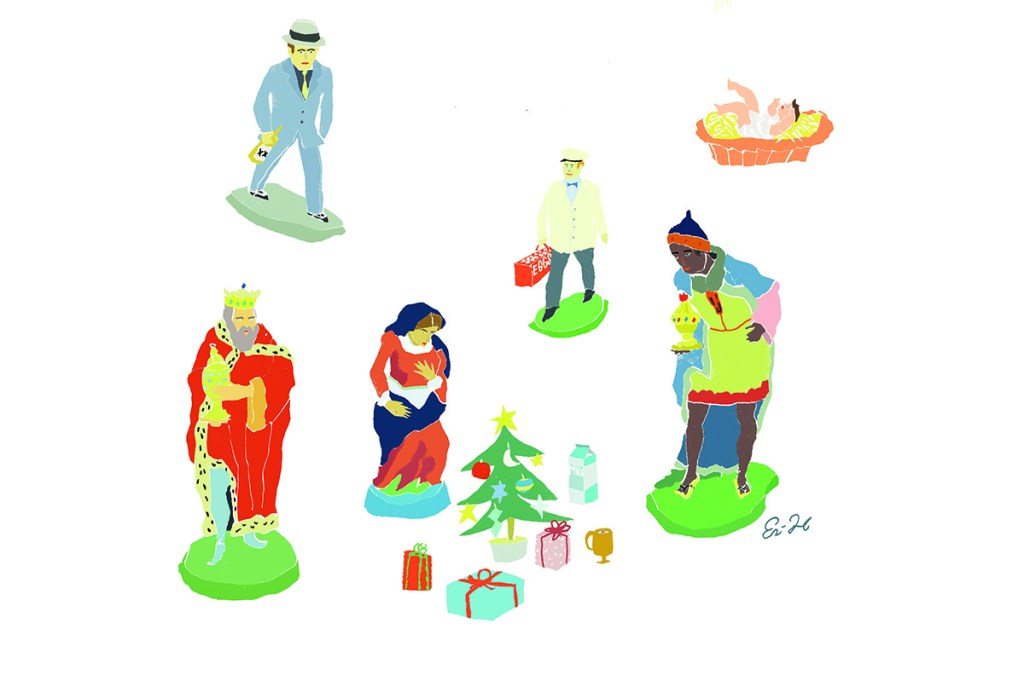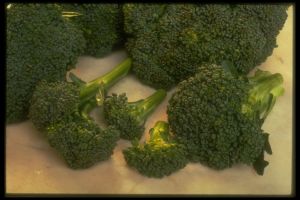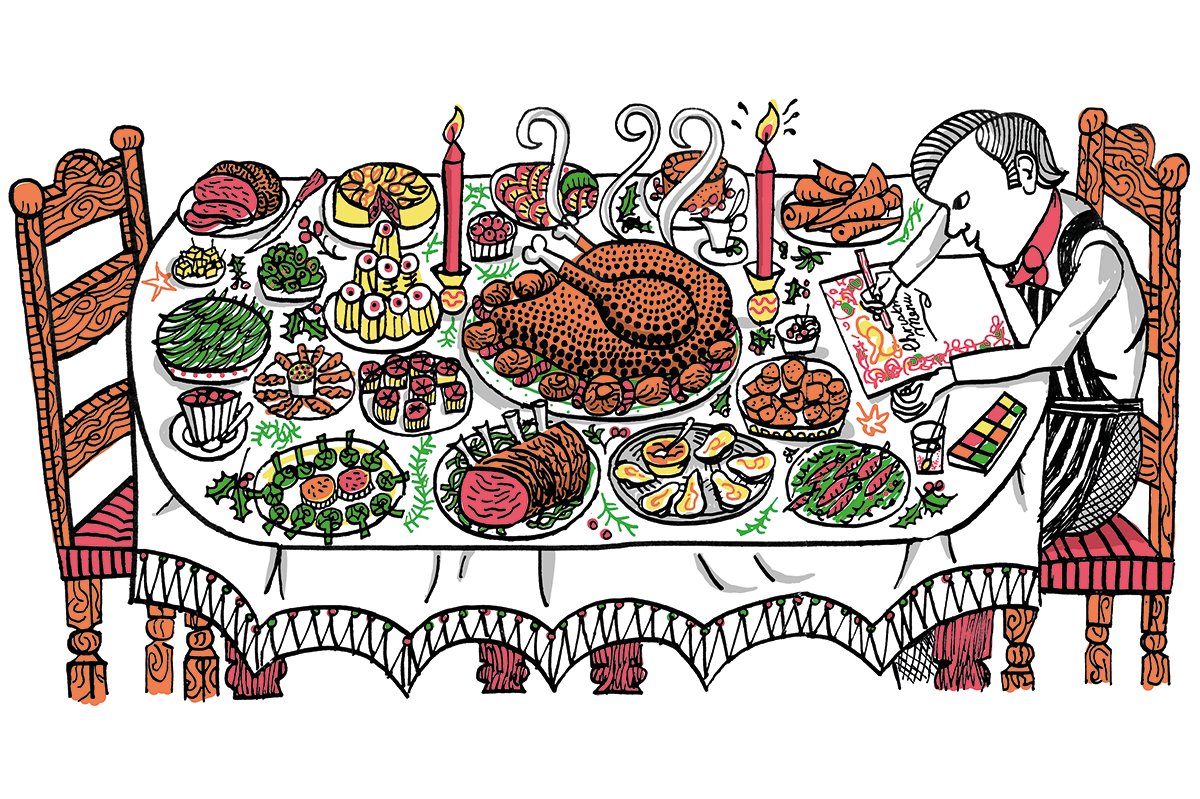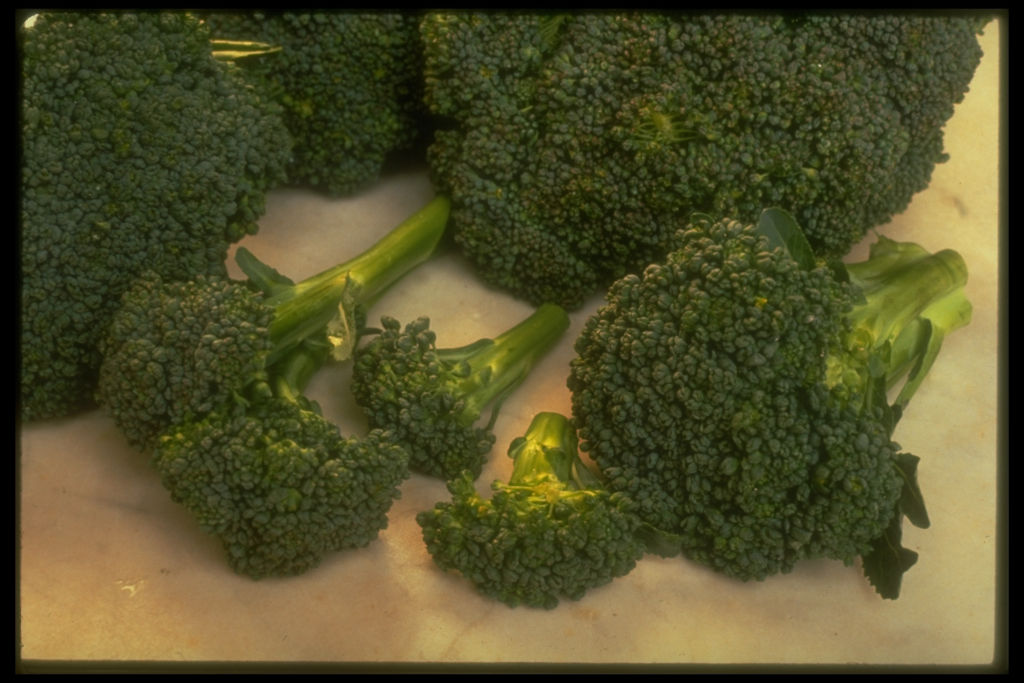Let Bing sing about a white Christmas, if he insists. My kind of Christmas is more eggnog-toned: yellowy, like old-fashioned incandescent string lights; rich, like real velvet ribbon on presents; topped with pale froth of the most nonutilitarian and fluffy kind; sweet, with a kick of rum or bourbon to redeem it from sentimentality; stippled with a dark sprinkling of freshly grated nutmeg on top to ginger up the olfactory receptors.
Uncanonical as it may be to view the Nowell season through an eggnog-tinted lens, it seems to me that food and wassail are more essential to Christmas than snow. What is the celebration without culinary traditions, even though one man’s festive favorite may be another’s pet peeve? Fruitcake, for instance, is both beloved and loathed (for me it’s definitely beloved, especially when coated in a heavy layer of marzipan). I am sure there are people who dislike eggnog, but 135 million pounds of it are sold in America every festive season, showing that the beverage’s charms are well appreciated. And there’s no way to calculate how many cooks whip up their own homemade versions, though the ubiquity of eggnog recipes leads one to believe there must be quite a number.
I’d say homemade eggnog is superior to storebought, but in fact the two drinks are so different that they don’t really bear comparison. It’s simple enough to make your own. The way we make it is to separate yolks and whites. The yolks are beaten with sugar first; then milk, cream and alcohol — spiced rum, brandy, bourbon, or a combination — are whisked into the sugary yellow mixture. Separately, the egg whites are beaten until soft peaks form and sweetened with sugar. Then they are folded into the yolk-based mix. Those concerned about the risk of salmonella in raw eggs can at this stage, if they wish, let the mixture sit in the fridge for a day; if there’s enough alcohol, twenty-four hours will apparently kill any bacteria. Others may wish to gently heat the mixture to pasteurization point, though this will affect the taste somewhat (not necessarily in a bad way).
To serve, pour into goblets and grate some nutmeg over the top. Ah, I can smell it now: the aroma of just-grated nutmeg, together with the scent of fresh pine needles, will always bring me back to my family’s living room on Christmas Eve: an enormous real tree newly dragged in and decorated; the Nativity scene set up, golden straw from the frozen field strewn about the feet of the various personages, a rose angel hung on the front of the stable, ready to announce the good tidings at midnight, overlooking the empty spot in the middle that awaits the manger.
It’s so difficult to write about Christmas. The temptations are multifarious — you can go the ironic route, claiming that the decorations are all just cheap plastic and that you keenly feel the injustice of having to get together with family and spend money and eat too many calories. Or you can fall into the trap of being deliberately sentimental, presenting yourself self-deprecatingly as one who derives a merely emotional benefit from holiday customs — the magic of Christmas, you know — aiming for sympathy at best and toleration at worst. Or you can be quietly agnostic: whatever it means to you or to me personally, we can all agree that it’s a great opportunity to — fill in the blank: entertain, drink eggnog or mulled wine, cook gastronomical marvels, indulge our inner decorator, enjoy music, see family and friends, practice generosity, show love, reflect on the meaning of life… so many ways of circling about the center, sometimes drawing closer but always in the end avoiding the dangerous gist of the thing, the empty spot in the middle. Like Prufrock, should we (after tea and cakes and ices) have the strength to force the moment to its crisis? And should we presume, and how should we begin?
Take it from Hilaire Belloc in his essay “A Remaining Christmas” (in my view one of the great essays of the English language): the value of Christmas customs lies in this, that they make “explicable, tolerable, and normal what is otherwise… shocking and intolerable… I mean, the mortality of immortal men.”
There you have it. No Prufrockian haltingness for Belloc, nor tiptoeing round the overwhelming question. Who wants to talk about mortality at Christmastime — and in a column about comestibles, for heaven’s sake? Belloc does, because the tension between mortality and immortality are at the heart of the matter: as insignificant and as variable as these traditions may seem, they are in a certain sense literally life and death. Why do we make the same recipes year after year, to be eaten at certain specific times? Why insist on piddling customs and minor ceremonies — how the stockings are to be hung, or the gifts to be opened, or what spice is sprinkled on the eggnog, and will it be served in pewter mugs? These are hardly matters of religious praxis!
But in a way, they are. Belloc speaks of the domestic rituals of Christmas as sustenance for both body and soul. They aid us in comprehending and coming to terms with mortality and with the trials of the human condition: loss, suffering, change. They put the “bitterness of living” into context, making it “part of a large business which may lead to Beatitude…” As we travel through our lives, they connect “in the memory with holy day after holy day, year by year, binding the generations together,” carrying on “the life of the dead…” They heal loneliness, rooting our isolated existences in “corporate substance, permanence and stability.”
(And here I picture, like an opera chorus, a crowd of all ages, men, women, children, those gone before us and those to come, in friendly shadow and gentle harmony, crowding around the spotlit circle where we the living hold the stage, mid-action, our swan songs still unsung.)
In the total absence of such sustaining symbols, Belloc writes with profound compassion — and his words ring even truer in our age of epidemic sadness than in his own — “the vast increasing burden of life might at last conquer us and be no longer borne.”
Body and soul must be fed. Let there be caroling, figgy pudding, gingerbread, evergreen wreaths and yes, eggnog. They are, quite literally, the stuff of life.
This article was originally published in The Spectator’s December 2022 World edition.

























